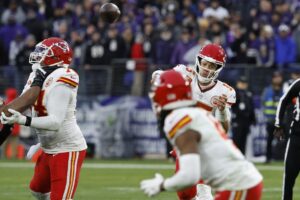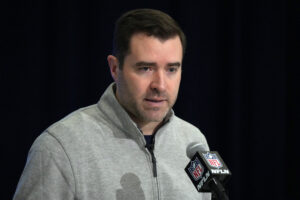Every year the path to victory does not begin in training camp, nor draft day, and not even free agency. Rather, the drive to Super Bowl LIII begins before the final plays of the 2017 season are physically concluded. Scouts, general managers, and personnel departments formulate plans and never rest on the laurels of success in the moment. The NFL is eternally a forward battle of getting better or dying now. While that may seem pessimistic, there really is only one winner at the end of the year.
Driving the pessimism even further is the fact that some teams must be virtuously honest with themselves if they fundamentally want to improve for the next season. One of those teams in the 2018 off-season is the Kansas City Chiefs – a team with options at several positions and growing needs due to age at others. There was a holistic lack of consistency in defense, and the very intrinsic structure of the system fell apart, Bob Sutton or not. With Brett Veach and Andy Reid coordinating their first off-season together as a general manager-head coach duo, the Kansas City Chiefs 2018 off-season is one which will determine the long-term scheme, outlook, and hope for the team.
Kansas City Chiefs 2018 Off-Season Options (Offense)
Since the Chiefs boast a plethora of options, both in the NFL Draft and free agency, the following is a quick summation of each position. As the off-season shapes up, be on the watch for more specific articles on the positions Reid and Veach put an emphasis on. Detailed draft profiles will be included as well.
The Chiefs currently have picks 54, 86, 118, and 182 in the 2018 NFL Draft. This does limit them to drafting very specific needs and not frivolously reaching for players. They are also $14 million over the cap, which will force them to move assets.
This article will focus on the offense, whereas the defensive off-season options can be read here.
Quarterback
There may be no bigger debate this off-season than the Chiefs quarterback. High-upside Patrick Mahomes is headed into his second year, while veteran Alex Smith is headed into his 13th. However, Smith is also coming off his first 4,000-yard season, and the best year of his career. Complicating matters further, Smith has a potential out on his contract this year, which would leave the Chiefs with $3.6 million in dead cap. Yet, the out would eliminate the potential situation where Mahomes is starting and Smith is sitting making $20.6 million.
There is no intrinsic problem with keeping both based on what has been observed so far from Mahomes and Smith. Considering Smith succeeded based on concepts initiated by Matt Nagy, who is now head coach of the Chicago Bears, and is coming off an anomaly of a season, regression to the mean is expected. Regression would leave the Chiefs with a quaint, game-manager quarterback who can get to the playoffs, but not win.
Keeping Mahomes alone would predicate he is ready, a major question that only coaches know the answer to. He has higher upside due to a bigger arm and a wider playbook set predicated upon his athleticism. However, the implication of his Brett Favre style of play could mean more turnovers.
One more wrinkle: Smith could be traded for a hefty sum to the Cleveland Browns, Arizona Cardinals, New York Jets, or Buffalo Bills among other teams. There are plenty of teams who will take a game manager at quarterback opposed to their current tragedy. Considering what $20.6 million of additional cap space could do (examining free-agent defenders will be coming), and the additional players or draft picks obtained from a trade, the inclination here is to trade Smith.
Assuming the coaches trust Mahomes, and he can hand the ball off 20 or more times to at least maintain the offense, freeing Smith from his contract is a necessary risk to fix other positions. No quarterback is winning with the current defensive roster set.
Running Back
After Kareem Hunt had a breakout rookie year en route to the NFL rushing title and Spencer Ware came back from injury, the Chiefs are set in the backfield. Not much should change, save the third-back option. C.J. Spiller – who played a singular snap and was a practice asset – probably will not be back. Furthermore, Charcandrick West is set to be a $2 million cap hit. He has a very specific role and knows the system, but would only be $333,334 of dead cap if the Chiefs decide to experiment more with Akeem Hunt or practice squad back George Atkinson. If any rookie receives a look, watch for Ralph Webb out of Vanderbilt.
Tight End
Travis Kelce is set to dominate again, but as noted in the wild-card loss to the Tennessee Titans and the stats conclusion to the season, the Chiefs other tight ends are not trustable sources of production. Demetrius Harris has nice length and catch radius but is mediocre at blocking and drops the ball too much to be on the roster (51.4 percent catch rate in 2017, 57.45 percent catch rate career average). The issue is only exacerbated if Mahomes starts and uses even more Reidian tight end sets than Smith did.
Standing at $2.2 million in cap hits, and impending doom when passed to, other options should be consulted. Since Kelce is on the roster, the Chiefs can settle for a consistent product over upside here.
Luke Willson of the Seattle Seahawks is a consistent pass receiver but may hit the same $2 million or more range. Additionally, Willson is likely to be re-signed before hitting free agency. Richard Rodgers, a free-agent of the Green Bay Packers, caught a stable 63.2 percent of passes last season, and most likely will not cost over $1 million. Brandon Williams of the Indianapolis Colts is hitting free-agency at 30, and while not bountifully successful, has been around the league and could fill in for Orson Charles at slot three.
The tight end draft class is not great, yet still has some interesting projects the Chiefs might love to look at due to their reliance on three-tight end sets. With only four draft targets, it all depends on front office value.
Tyler Conklin out of Central Michigan is a highly productive, lumbering pass catcher who fits precisely at pick 118. If they choose to wait, Ian Thomas (Indiana) has the typology as well as the raw receiving talent the Chiefs like. Thomas operates with route precision but did not receive the targets to overtly produce.
Wide Receiver
The tight end question is nuanced and fun because of the scheme. The wide receiver question is a blaring alarm of deep concern. Save Tyreek Hill, the Chiefs wide receivers are a giant question mark built on inexperience. Chris Conley showed number two upside at times, but a torn Achilles ended his rookie campaign early. The other targets are Jehu Chesson, who lacked production at camp and in the pre-season, and a bevy of experiments in Marcus Kemp, Daniel Braverman, Gehrig Dieter, and Demarcus Robinson.
Albert Wilson is the unknown and trendsetter in this situation. He has evolved into a wonderful slot receiver target but is a free agent and may demand more money than the Chiefs are willing to pay (estimating $3-4 million per year). Unfortunately, ‘should be re-signed’ and ‘can be re-signed’ are two different scenarios.
Even if Wilson returns, he is merely a slot receiver. Hill fills the number one slot but is atypical. There is a need to go after a stable, traditional target reminiscent of Jeremy Maclin. The Chiefs current scheme is too easily solidified into an easily defendable typology.
In free agency, assuming massive freeing of salary elsewhere, the Chiefs targets are still limited. Sammy Watkins, Mike Wallace, Terrelle Pryor, and Kendall Wright are some of the bigger names, but they are either plagued by mediocrity, injuries, or likelihood of being re-signed. Analytically, signing one of the ‘bigger names’ this off-season may be a futile move for marked improvement.
Allen Robinson is set to hit the market from the Jacksonville Jaguars, and even though he is coming off an injury, would be the best of the prominent free agents. Robinson would be expensive (roughly eight million, at the low end), but his production would be enough to overlook the risk in relying on Conley as the number three.
Justin Hunter, Brian Quick, Jeff Janis, and re-signing De’Anthony Thomas are other options to fulfill the back end of the roster at a smaller cost. The other reason Robinson or other prominent signings should be unexpected is due to Hill’s contract. Although he is signed over the next two seasons, he will be demanding a premier deal off his rookie contract in the range of $10 million. A long-term receiver this season would imply a large part of the future salary cap is allocated to the offense, the Chiefs move on from Justin Houston and Derrick Johnson upon Hill re-signing, and reformulating as an offensive identity. With Mahomes, however, the option is debatable at least.
Knowing Reid loves his defensive players, and thus a heavy investment in the offense is unlikely, the Chiefs will most likely draft a wide receiver. Fortunately for them, this class is rich. Unfortunately, the richness may implicate a run on receivers early, forcing their hand at 54 instead of 86. One specific option would be to trade 54 while falling back to the mid-60s and obtaining another pick without being forced to reach for a receiver.
One of the quicker receivers who is currently rising is Anthony Miller out of Memphis. He is smaller at 5’10” and still produced with 92 receptions for 1,462 yards with an uncanny ability to stretch the field. His route running is naturally a part of who he is, an asset the Chiefs desperately need. However, the smaller body makes him susceptible to press coverage, leaving heavy doubts with his technique off the line against bigger cornerbacks.
Dante Pettis from the University of Washington would be a compelling selection. Having broken Desean Jackson’s Pac-12 punt-return touchdown record at nine, Pettis brings more value than just wide receiver. Pettis is quick, light on his feet in cuts, but needs to produce better route concepts. Without that refinement in the route tree, he may be another glorified man on the field. Fortunately, that risk may implicate he drops to pick 118, or farther, pending on how others rise.
Save the best for last – Jaleel Scott out of New Mexico State. Standing at 6’6”, Scott would provide the big frame the Chiefs have never owned. His catch radius is exquisite, his fundamentals are precise, and he contested, beating most, every cornerback he met in college. Scott may be a sleeper, falling to pick 118, but he could rise as well depending on performance in the upcoming drills. He is a refined target that may not have the big-time capability other players do, but his consistency and typology are exactly what the Chiefs have been missing.
Offensive Line
Fortunately for the Chiefs, they have an above average line paid exactly as they should. Yes, Eric Fisher has his issues, and complaints can be found with Laurent Duvernay-Tardif and Mitchell Schwartz’s health. By and large, though, the Chiefs have a good enough offensive line for their current roster. There will not any changes to the starting five of Fisher, Duvernay-Tardif, Schwartz, Bryan Witzmann, and Mitch Morse.
The questions arrive at backup. Zach Fulton and Cameron Erving were decent at times but reprehensible at others. Pick 182 may end up being a line of scrimmage pick, either on offense or defense. Reid has a propensity for drafting players whom can play across the line, implicating undrafted free agent targets to watch are Brendan Mahon (Penn State) and K.C. McDermott (Miami), who played both at guard and tackle. A higher slotted target for 182 would be Scott Quessenberry from UCLA – a guard and center prospect who showed interior leverage but needs to be quicker in lateral movement.
Reid has shown more aptitude toward younger backups whom he can groom, making free-agency an unlikely spot. The youngest guard in free-agency is Marcus Martin of the Cleveland Browns, sitting at 24. With Jordan Devey being a free agent (age 30), and not likely to arrive on the roster, prominence may be placed on a center such as Josh LeRibeus (age 28) or Tim Barnes (age 29) to fulfill the veteran, low-cost role.
Be sure and check out the Chiefs 2018 off-season options on the defensive side of the football.
Main Image:






